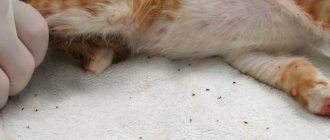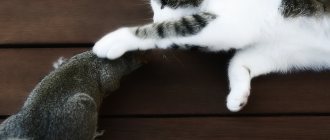What are worms (helminths)
Helminths are a whole group of parasitic worms that can live in the body of humans or animals and cause helminthiasis - parasitic diseases. Worms destroy the body of their host from the inside, absorbing useful substances and releasing toxic toxins in the process of their life.
There are more than 30 types of helminths: round, flat, tape, flukes... All of them can parasitize a cat’s body, but the most common are the following:
- tapeworms (cestodes) - parasitize the cat's intestines. They can reach up to 70 cm in length. Their entire body consists of many segments in which new larvae are constantly formed;
- Roundworms (roundworms) are the most common in cats. They can live in all organs of the animal, but most often accumulate in the small intestine and can cause blockage of the bile ducts and intestines, which is deadly for the cat. They have a very strong toxic effect on the animal’s body;
- nematodes - small white worms that feed on blood; are less common than others. Nematodes attach to the blood vessels of the intestine and in severe cases cause anemia, internal bleeding, and can lead to the death of the animal.
All helminths that parasitize cats can also parasitize humans. Children are especially likely to “adopt” worms from cats.
Regardless of the degree of infection, worms deplete and weaken the cat’s body. A sick animal must be treated, as well as regular infection prevention, since it is very easy for a cat, even a domestic one, to “catch” worms.
Danger of worms
The body of an infected animal is destroyed by worms in two directions.
Firstly, worms cause mechanical damage to the organs in which they are localized (and this can be not only the gastrointestinal tract, but also blood vessels, lungs and even the heart): trying to gain a foothold on internal organs or migrating, the parasites scratch them with their chitinous shells and jaws at attachment points.
Secondly, worms poison the animal. During their life, they release substances that cause intoxication in the cat’s body. As a result, cats' immunity decreases and their metabolism is disrupted. In advanced cases, the infected organs decay, and diseases of the nervous system occur, including paralysis of the hind limbs.
Since worms parasitize the cat’s body, a considerable part of the nutrients from the food is not absorbed by the animal, but goes to the worms. All this leads to a weakening of the body as a whole, cats begin to get sick more often and recover more slowly. Infected animals are more susceptible to infections not only because of weakened immunity, but also because of internal organs injured by worms.
Dead parasites in the process of their decomposition also poison the cat’s body.
How does a cat become infected with worms?
No matter how creepy it may sound, helminths and their larvae are everywhere: on the ground, on the grass, in any park or garden, in any soil and even in water, not to mention raw meat, fish and unwashed vegetables. In addition, many pest animals such as rodents are either themselves infected with worms or are carriers of parasites.
If your cat regularly goes outside, then he almost certainly has worms. But even if you have a domestic cat, she can pick up the infection very easily: we all constantly bring worm eggs into the house on our shoes (and sometimes on our hands!), so for a cat to become infected, it is often enough to walk on the dirty floor in the hallway or sniff the owner's shoes, and then lick your paws or nose.
Another source of danger is insects. Cats often hunt flies that fly into the room, and when they catch their prey, they eat it with pleasure. But flies and mosquitoes are intermediate links in the transfer of helminth eggs.
Often, infection with worms occurs due to eating raw meat or fish, especially river fish. However, pre-freezing and washing meat is not a panacea.
In kittens, infection with worms can occur from the mother or through consumption of mother's milk, or even at the stage of intrauterine development. In addition, cats become infected from each other through contact with infected animals. So if you have several cats, and one of them has worms, you need to treat all of them at the same time.
Causes and routes of infection with tapeworms
The life cycle of tapeworms is as follows:
- an adult worm, parasitic in the small intestine of cats and dogs, discards a segment of its body (segment) with eggs, which is released along with feces;
- eggs released into the external environment are eaten by an intermediate host (for example, a flea or lice eater);
- a cat or dog swallows the intermediate host, and the larva develops into an adult worm in their body.
The sizes of cysts (eggs covered with a fairly durable shell) are so small that they easily penetrate the body of cats and dogs - their main hosts, and the cycle begins anew.
Naturally, the question arises: are these parasites transmitted to humans and dangerous to humans or not? Unfortunately, both questions will have to be answered positively: yes, they are transmitted and yes, they are dangerous.
However, the source of helminth infection is not only fleas and lice eaters. We ourselves bring worm eggs on the soles of our shoes, because they, as a rule, have good survival in the external environment and are found literally everywhere: on land, in water and even in the air, where they are carried by the wind.
Therefore, even in the absence of contact with street animals, helminthiasis may well develop at home, let alone those who “walk on their own”!
How to tell if a cat has worms
Signs of helminth infection manifest differently in different animals. This depends on the age and immunity of the cat, as well as the degree of worm infestation. Sometimes symptoms may not appear at all, and sometimes they can be confused with infectious diseases.
The most common signs that cause suspicion are:
- problems with the gastrointestinal tract, digestive disorders - the cat suffers from constipation, alternating with diarrhea, and often vomits after eating. The tummy is swollen and seems tightly stuffed. Due to general intoxication of the body, loss of appetite occurs (but sometimes appetite is significantly increased). In any case, the animal is exhausted;
- dull fur, festering eyes - the presence of parasites almost always affects the appearance of the cat. The fur becomes faded and as if disheveled, and sometimes begins to fall out. The eyes also lose their healthy shine, appear dull, pus constantly accumulates in the corners, and nasal discharge may begin;
- itching in the anal area - you can notice if the cat begins to “crawl” on the floor. Often irritation occurs around the sphincter, hair begins to fall out, and a small rash appears;
- blood in the stool - most often appears in advanced cases, with a strong degree of infection. Sometimes you can see parts of worms;
- fleas – the presence of fleas in an animal’s fur is an almost 100% guarantee that it also has worms. When licking, larvae of tapeworms, carried by fleas, enter the cat’s body, and now the pet is already infected.
It should be remembered that neither the presence nor the absence of these symptoms can absolutely reliably answer the question of whether a cat has worms. At the slightest suspicion, the animal must be taken to the veterinarian in order to accurately determine the cause of the pet’s ailment by conducting laboratory tests. In addition, it is necessary to give your cat anthelmintic drugs quarterly to prevent helminthiasis.
Rules for taking medications for worms
Before choosing a deworming drug for your pet, it is necessary to find out by taking tests from a veterinarian what kind of worms the animal is infected with. The veterinarian will prescribe a specific medication and treatment regimen.
As a preventive measure, animals can be given complex-action drugs once a quarter. Pets are also given worming 7-10 days before vaccination!
Before you administer the medicine yourself, you must read the instructions for the medicine. You should not use several different anthelmintic drugs at the same time - the active ingredients may be incompatible with each other!
Prevention of helminthiases
It is easier to prevent a disease than to fight it and its consequences. Therefore, certain preventive measures should be observed:
- regularly inspect the animal for the presence of fleas, ticks and lice, and if they are found, immediately take measures to destroy the insects;
- do not give your pet raw fish and meat, but only heat-treated foods or special animal food;
- keep the cat away from outdoor shoes;
- limit contact with street animals;
- treat the tray with special disinfectants, and periodically wash the cat’s sleeping place or bedding;
- Do wet cleaning in the house regularly;
- Once every three months, give the cat antiparasitic drugs for the purpose of prevention, but they must be selected by a doctor on an individual basis.
Following simple prevention rules will reduce the risk of your cat becoming infected with helminth infections.
Anthelmintics
There are many modern effective anthelmintic drugs. They differ in their spectrum of action: some drugs kill only one type of parasite, while most act in a complex manner.
Based on the form of use, anti-worm medications are divided into several groups, and here you will have to experimentally find out which option is best for your pet.
Most often you can buy tablets in pet stores, such as:
- Drontal, cestal - acts on round and tapeworms, one tablet is given per 4 kg of animal weight;
- Milbemax/Milprazone is a complex-action drug that is destructive to both adult worms and their larvae; effective not only against worms that have settled in the intestines, but also in blood vessels and the heart;
- Dirofen - has a pronounced complex effect, but is especially effective against nematodes and tapeworms; It is also available in the form of a suspension and paste.
When giving medicine, under no circumstances should you frighten the animal, squeeze it, or hold it forcibly. Gentle stroking of the withers and neck will calm the pet, and then you can gently open its mouth and quickly place a pre-prepared tablet on the root of the tongue. After this, you need to close your mouth and, trying to hold her head up, lightly stroke her neck, encouraging her to make a swallowing movement.
If your pet stubbornly spits out the tablet, you can crush the drug and either mix it with your favorite cat treat, or dilute it with water and carefully inject it into the mouth from a syringe (without a needle!).
Suspensions
Suspensions are more convenient for use. Included with the medicine is an atraumatic syringe, with which it is not only easy to measure the required amount of the medicine, but also to quickly give the medicine to the cat. The main thing is to also try to get it on the root of the tongue so that the pet swallows the suspension.
The most common suspensions are Prasitel, Prazicide and Dirofen. Prazitel has a complex effect, killing parasites at any stage of development. Another advantage of this suspension is the absence of any taste.
Drops on the withers
Another type of anthelmintic drugs is drops on the withers: Stroghold. The medicine according to the dosage is applied to the withers of the animal, after a few days the procedure is repeated.
Treatment
It is important to diagnose helminthic infestation in time. Timely treatment will allow you to quickly get rid of parasites. Today there is a large selection of anthelmintic drugs for cats. They allow you to easily cope with helminths at any stage of development, without causing a toxic effect on the pet’s body. Available in a variety of forms. Your veterinarian will help you choose the right medicine and determine the dosage, taking into account the type of worms and the general condition of your pet.
Pills
There are drugs in tablet form that are used once. You can give the medicine forcibly by placing the tablet on the root of the tongue, or crush it and mix it with water and pour it into the mouth using a syringe. During the treatment process, it is important to ensure that the pet does not spit out the medicine. The most popular medications to help control tapeworms in cats are:
Kanikvantel fights all types of worms
- Holiday plus. The active ingredients are fenbendazole and praziquantel. By interacting with each other, they block the functioning of the muscle and nervous systems of the parasites, which causes the death of the latter. The remains of worms are excreted in the feces. The dosage depends on the weight of the pet - one tablet is designed for 10 kg of weight. If the cat weighs 5 kg, then he needs to be given half the tablet. Kanikvantel is suitable both for the treatment of helminthic infestation and for prevention. In severe cases of the disease, it is recommended to take the medication again after 2 weeks. The drug has a gentle effect. Even a significant excess of the dosage does not have a negative effect on the body. In rare cases, adverse reactions such as vomiting and diarrhea are possible. These symptoms usually go away on their own after a few hours. This product is contraindicated in pregnant cats and kittens under three weeks of age.
Drontal belongs to the group of the most effective drugs
- Drontal. Available in the form of white coated tablets. The active substances pyrantel embonate and praziquantel have a paralyzing effect on helminths, which leads to their death. Quickly absorbed into the intestinal villi, they penetrate all organs. Excreted through the kidneys. Easily tolerated by all cats, regardless of breed and age.
Pratel is effective against many types of parasites
- Pratel. Praziquantel and pyrantel are the main components. The drug is a yellowish anthelmintic tablet that is effective against many types of parasites, including tapeworms. By paralyzing the muscles and blocking the transmission of nerve impulses, it destroys adult helminths, as well as larvae.
Medicine for worms must be given exactly according to the indicated dosages.
Drops on the withers
This form of anthelmintic drugs is convenient when the animal refuses to take the medicine orally. Drops are applied to the occipital region once. Effective:
Profender is prescribed against many parasitic diseases
- Profender. An anthelmintic drug used for therapeutic and prophylactic purposes. Available in the form of a solution containing emodepside and praziquantel, components known to be effective against tapeworms. Having penetrated the animal’s skin into the body, the drug paralyzes the neuromuscular system of the parasite, causing its death. It can be maintained for a long time in therapeutic concentrations and is eliminated within 30 days.
Stronghold is capable of destroying adults and larvae
- Stronghold. A colorless solution containing selamectin as an active substance. Effective against many parasites, providing reliable protection for a month. If the specified dosage is observed, the drug is completely safe for the pet’s health.
Prazicide is a drug for complex use
- Prazicide-complex. Broad spectrum drops. The composition includes a complex of active substances - praziquantel, ivermectin, levamisole, thiamethoxam. Refers to moderately dangerous drugs.
Drops are applied to the occipital region once. Having parted the animal's fur, squeeze the contents of the pipette onto the skin in accordance with the recommended dosage. Manipulation should be carried out carefully so that the medicine does not get on your hands.
Suspensions
The medicine has a sweetish taste. Injected into the oral cavity using a syringe. The following drugs have found widespread use:
- Prazicide plus. Suitable for adult animals and kittens over 3 weeks old.
Pyrantel is one of the effective remedies against ascariasis
- Pirantel. Leads to disruption of the motor function of parasites, as a result of which tapeworms cannot attach to the intestinal walls and are excreted from the body. The drug cannot affect migrating larvae.
- Prazitel. Disturbs the energy metabolism of parasites. Output quickly.
The advantage of drugs in the form of a suspension is the inability of the animal to remove the injected drug from the mouth.
Prevention of helminthic infestations
It's no secret that any disease (including feline helminthiasis) is easier to prevent than to treat. In addition, it should be remembered that the helminths that infect cats can easily infect humans. To do this, it is not at all necessary to kiss the purr: there are worm larvae on the fur of sick animals. So you need to protect your cat from a dangerous disease, including for your own safety.
To prevent helminthic infestations in cats it is necessary:
- keep the house clean: regularly wash the floor at the front door, clean door mats, put shoes out of reach of the cat;
- wash your hands before cuddling your cat after returning home from the street;
- do not feed your cat raw meat or fish; it is also better to give boiled or filtered water;
- keep your pet's toilet clean: excrement must be removed immediately, and not only change the filler, but also wash the tray itself;
- If possible, do not let the cat go outside;
- install mosquito nets on the windows to prevent flies and mosquitoes from entering the apartment;
- every three months to prevent infection, use anti-parasite products (not only worms, but also fleas and ticks).
Following these simple rules will reduce to a minimum the likelihood of a cat (and therefore its owners) becoming infected with worms.
Prevention of worms in cats
Prevention of infection with worms in cats is perhaps the most important means of helping to preserve the health of the pet and its owner.
To do this, it is necessary to prevent healthy animals from coming into contact with untreated ones, feed them with ready-made or heat-treated food, keep shoes and outdoor clothes in a closet to which the cat does not have access, and keep the litter box clean.
Particular attention is paid to preventive treatment schemes using veterinary anthelmintic drugs:
- For cats that do not go outside and do not have contact with other animals, treatment is recommended 2 times a year, or testing feces for worm eggs.
- For cats that periodically walk outside under the control of the owner and communicate with other treated animals, prophylaxis is carried out 3 times a year.
- Cats that hunt mice, often walk outside, or interact closely with untreated animals are recommended to be treated 4 or more times a year.










